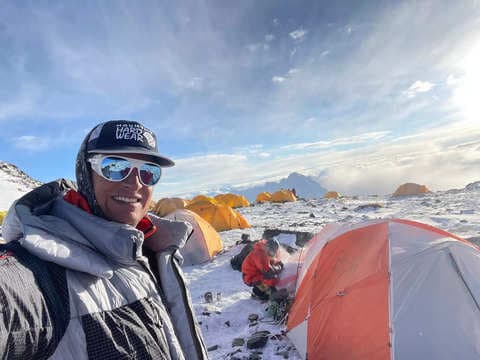- Mountaineer Garrett Madison recently summited Mt. Everest, Mt. Lhotse, and Mt. Nuptse this season.
- This is his second time doing it, earning him another Everest "triple crown" of mountaineering.
Few people have successfully summited the Everest region's "triple crown."
These three peaks — Mt. Everest, Mt. Lhotse, and Mt. Nuptse — are some of the most dangerous climbs, boasting some of the harshest conditions on Earth: freezing temperatures, low oxygen levels, and treacherous terrain.
Summiting any one of these three peaks could risk your life. Climbers can die from severe altitude sickness, falls into deep crevasses, exposure, and other threats.
Professional mountaineer Garrett Madison has achieved the Everest triple crown not once, but twice — first in 2023, the deadliest Everest climbing season on record, and again this year.
But visiting the top of the world isn't just about climbing for Madison anymore. He's summited Mt. Everest 14 times, and after years of watching trash accumulate on the mountain and its surrounding peaks, he's decided to tackle the issue head-on.
He started the Madison Mountaineering Mountain Cleanup Project in the fall of 2023, and he and his team have now collected a total of 4,000 pounds of trash — 2,000 pounds in 2023 and another 2,000 pounds this year — from Everest and neighboring peaks.
"I think we've made a big dent. There's obviously more work to be done," Madison told Business Insider.
Cleaning up polluted peaks
Picking up trash on some of the world's tallest mountains adds yet another layer of complexity and intensity to an expedition like this, Madison said.
"It's not just like walking down the street and picking up trash out of the ditch. It's really hard work," he said.
Doing any sort of physical labor at such a high altitude, while also spending entire days climbing, can lead to exhaustion fast.
Plus, the climbers have to carry extra protective equipment like gloves and packages for transporting the trash down the mountain. Every additional pound is extra strain.
"Our teams could only work for like an hour at a time before they'd have to rest," Madison said.
The climbers also had to be wary of dangerous terrain. Most of the trash is in the camp areas, which are relatively flat, Madison said. But Camp 3 is located on the Lhotse Face, which is very steep with a high risk of avalanches and falling rocks.
"That's a treacherous area to be operating in, you don't want to fall. People have fallen down and died," he said.
But for Madison and his cleanup team, the work is worth the risk.
Pollution flows down
The Sagarmatha National Park and Buffer Zone, which includes Mt. Everest and seven of its neighboring peaks, has a serious trash problem. Most of the garbage is left behind by climbers, and includes stuff like abandoned tents, discarded food packaging, and empty oxygen canisters.
A 2010 study estimated that park tourism generated roughly 4.6 tons of solid waste per day during climbing seasons. But that number is likely higher today, because the amount of people climbing these peaks has generally increased since then while garbage disposal methods are still lacking.
Waste management rules on Mt. Everest haven't been well-enforced, Troy Aupperle, an experienced mountaineer who climbed Everest twice and summitted once, told Live Science in 2022. And he doesn't think most climbers are all that concerned with carrying their trash back down the mountain.
"You barely have enough energy to get yourself off the mountain, so anything you don't have to carry or can get rid of, you just off-load so you can get down," Aupperle told Live Science.
All that waste is polluting critical water resources for local communities, Madison said. "Where does all that trash go? It'll flow down the glaciers into the streams and rivers and water sources that communities rely upon," he said.
Plus, discarded climbing equipment can break down into microplastics, which have been found in water and snow samples at Everest's base camp.
"Of course, what we really want to see is a change in policy and attitudes through education, where it's no longer acceptable to leave trash behind up there." But it's been a challenge.
In 2014, for example, Nepal's government instituted a rule requiring every mountaineer who climbs above Everest's base camp to return with 18 pounds of trash from the mountain, or forfeit a $4,000 deposit. But many people just forfeit the money, Alton Byers, a mountain geographer wrote in an article for The Conversation in May.
Madison's cleanup project is perhaps one of the most recent efforts but it's certainly not the first. In 1991, local Sherpa people created the Sagarmatha Pollution Control Committee (SPCC), which monitors waste on the permit-required peaks in this region, like Mt. Everest, Byers wrote.
And in 2019, the nonprofit Sagarmatha Next started a "Carry Me Back" program that encourages tourists to take two-pound bags of trash out of the mountains to be properly processed and disposed of.
Madison's cleanup project partners with both of these organizations in a united front against trash pollution on the world's tallest peaks.
"It's been an honor, very exciting to work with them a little bit," he said.
Madison hopes that his clean-up project helps reduce the environmental impact that climbers have on Mt. Everest and other peaks in this region.
"It's a lot of work, but it's definitely worth it. I feel really lucky and privileged to get to go on these expeditions," Madison told Business Insider.
